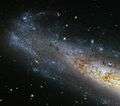NGC 1448
| NGC 1448 | |
|---|---|
|
| |
| Observation data (J2000 epoch) | |
| Constellation | Horologium |
| Right ascension | 03h 44m 31.9s[1] |
| Declination | −44° 38′ 41″[1] |
| Redshift | 1168 ± 2 km/s[1] |
| Distance | 56.5 ± 7.6 Mly (17.3 ± 2.3 Mpc)[1] |
| Apparent magnitude (V) | 10.7 |
| Characteristics | |
| Type | SAcd [1] |
| Apparent size (V) | 7′.6 × 1′.7[1] |
| Other designations | |
| NGC 1457, PGC 13727[1] | |
NGC 1448 or NGC 1457 is an unbarred spiral galaxy seen nearly edge-on in the constellation Horologium. It is at a distance of 55 million light years from Earth. It was discovered by John Herschel in 1835. Four supernovae have been discovered in NGC 1448, SN 1983S (14.5 mag, type II), SN 2001el (14.5 mag, type Ia), SN 2003hn (14.1 mag. type II), and SN 2014df (14.0 mag., type Ib).[2] From the spectral analysis of SN 2001 el, over a dozen diffuse interstellar bands were discovered in NGC 1448, one of the few cases that these bands were observed outside of the Milky Way. However, the bands were significantly weaker at SN 2003hn.[3]
In January 2017 it was announce that evidence for a supermassive black hole in NGC1448 had been found[4]
The galaxy belongs at NGC 1433 group,[5] part of the Doradus cloud of galaxies.
Gallery
 NGC 1448 taken by the Hubble's Wide Field Camera 3.[6]
NGC 1448 taken by the Hubble's Wide Field Camera 3.[6]
References
- 1 2 3 4 5 6 7 "NASA/IPAC Extragalactic Database". Results for NGC 1448. Retrieved 2016-01-18.
- ↑ List of Supernovae IAU Central Bureau for Astronomical Telegrams. Retrieved 29 December 2015.
- ↑ J. Sollerman; N. Cox; S. Mattila; P. Ehrenfreund; L. Kaper; B. Leibundgut; P. Lundqvist (January 2005). "Diffuse Interstellar Bands in NGC 1448". Astronomy and Astrophysics. 429 (2): 559–567. Bibcode:2005A&A...429..559S. arXiv:astro-ph/0409340
 . doi:10.1051/0004-6361:20041465. Retrieved 16 January 2016.
. doi:10.1051/0004-6361:20041465. Retrieved 16 January 2016. - ↑ Two monster black holes found lurking in nearby galaxies
- ↑ Dmitry Makarov; Igor Karachentsev (2011). "Galaxy groups and clouds in the local (z∼ 0.01) Universe". MNRAS. 412 (4): 2498–2520. Bibcode:2011MNRAS.412.2498M. arXiv:1011.6277
 . doi:10.1111/j.1365-2966.2010.18071.x. Retrieved 1 January 2016.
. doi:10.1111/j.1365-2966.2010.18071.x. Retrieved 1 January 2016. - ↑ "Seeing things sideways". www.spacetelescope.org. Retrieved 13 March 2017.
External links
- NGC 1448 on WikiSky: DSS2, SDSS, GALEX, IRAS, Hydrogen α, X-Ray, Astrophoto, Sky Map, Articles and images
